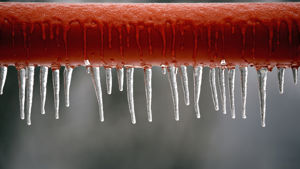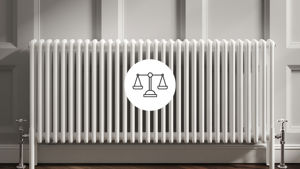You can't use normal paint to paint a radiator, yet painting a radiator is cheap, easy, and fun - when you do it properly. It's a real problem when you do it wrong. But, provided you know a few pointers first, you'll be painting your radiators every colour of the rainbow in a couple of minutes.
It's not something that people think about, painting a radiator, so this article is more an encouraging nudge for more people to get out a brush and let their creativity flow. If your radiator is still performing nicely with no cold spots, and has no cold bottom either then painting it might be good way to avoid buying a whole new radiator. So let's get to it with this article on how to paint a radiator properly.
Can I Paint My Radiator?
If you can pick up a brush and don't mind kneeling or bending down, or getting a step ladder in the case of vertical radiators, then yes, you can paint your radiator without much effort and for a surprisingly cheap price. You just need the right stuff to do it, which you can find below depending on whether you're using a brush or spray paint.
What Colours Can I Paint My Radiator?
Whatever colour you like as long as you use the correct type of paint. If you want a suggestion, my favourite colour is purple; but, really, paint it whatever colour you like. Black and white are very common colours but if you're looking for something more bespoke why not try green? Why not mix it up and paint it with multiple colours? (Just, make sure you apply some common sense and keep your coats as even as possible.)
Do I Have to Remove My Radiator From the Wall Before I Paint It?
Ideally, yes. But fear not if you just can't be bothered, because you don't have to. Since it's not a physical requirement, it just comes down to what is easier. If you're handy and have the tools and space, then removing your radiator from the wall won't be much of an issue. But if you've never done it, don't have the tools, and have no space, then having the mostly-hidden side of your radiator unpainted might not be such a bad trade-off.
How Do I Paint the Back of the Radiator If I'm Not Removing it?
You have 2 options, with the first option being "you don't" and the second being "with a bit of difficulty or a special paintbrush." Obviously your radiator is the biggest factor here, but you can buy special radiator paintbrushes for this very job; just take a look in your local DIY store or favourite online retailer.
What Paint Should I Use on My Radiator?
Why You Can't Use Normal, Everyday Paint
NOT normal house paint. We don't sell radiator paint (at the time of writing, anyway) so take it from 100% unbiased me - don't use normal house paint. You CAN use normal house paint IF you've applied a proper undercoat and are painting on the correct type of radiator. But you're just asking for problems, really. A radiator constantly heats and cools, which weakens paint; expands and shrinks, cracking weakened paint; and accumulates all sorts of dust and grime, which can literally bake into it, discolouring and permanently bonding to it.
How to Paint a Radiator with Normal, Everyday Paint Anyway
You're an independent spirit, so if you're set upon using normal paint then just apply a 'clear radiator overcoat' to be able to use standard emulsion. We only recommend this for cast iron and steel radiators, though.
You'll Need to Prime Your Radiator First
Buy either a specialist radiator primer or metal primer to give your paint a proper surface to bond to, and will stop rust with its anti-corrosive properties. Skipping the primer will just result in a dull finish and possible rust issues.
Paint Your Radiator With Heat-Resistant Paint
What you should use when painting any radiator is a heat-resistant radiator paint. You can buy it in the form of the usual paint tins, or in aerosol form for spray-painting it on. We'll cover both in this guide.
Can I Spray Paint My Radiator?
Yep, with the right heat-resistant radiator spray-paint! But it would be madness to leave your radiator on the wall while you do it. So as long as you buy the right radiator spray and remove your radiator properly, then we'll cover spray painting after the 'paintbrush method' section.
Can I Paint My Radiator Pipes?
Yes you can ! Just make sure you're still using the appropriate paint and preparation steps we mentioned above.

What You'll Need To Paint Your Radiator:
- This "How to Paint a Radiator" article, of course
- Stuff to clean your radiator with: read this cleaning article
- Old sheets or newspaper or anything to protect your floor from paint
- Sandpaper
- Radiator paint (tinned or spray) in your choice of colour
- Radiator primer
- Various paint brushes (If using paintbrushes. 1 will do, but a pack will be more useful)
- (Optional) if you're painting your pipes, or not taking your radiator off the wall, then put a large sheet of spare cardboard (or similar) between the radiator and the wall. They're usually really close together.
How to Paint a Radiator:
- Turn off your heating
- Clean the area around the radiator
- Clean and sand the radiator
- Prime the radiator
- Paint the radiator
- Apply another coat if necessary
Full Step By Step Guide:
1. Turn Your Heating off and Ventilate the Room
So obvious that it's easy to forget. Wait until it's stone cold so your paint doesn't get drippy (which can happen even if the room is too hot, so if your radiator is warm then it's a problem). And also ensure your room is well-ventilated when you begin to paint. If you have to open a few windows while the heating is off, then being temporarily cold is WAY better than having permanent health issues.
2. Clean Around the Radiator
Hoover up around the radiator to clear away loose dust, hair, and anything that might get disturbed and become stick in the paint. Then lay whatever you've got to hand to catch dripping and splashing paint. No matter how careful you are, no matter if you're the most careful person you've ever known, paint is going to splash on the most expensive object within 2 metres. Guaranteed. So put some sheets down and clear the space.
3. Clean the Radiator & Sand Down Lumps of Paint and Rust
Follow this cleaning guide to scrub that filthy rad, and then sand it down using your sandpaper. The goal is to remove any lumps of paint, rust, and anything that will make your coats of paint uneven.
4. Prime Your Radiator
Prime your radiator with an even coat. This will create a fresh surface for your paint to bond to. It's a quick thing to do that will ensure you get the best results possible. It will also stop and prior rust spots with anti-corrosive properties and protect against future rust problems. If your radiator is bare, or your pipes are bare, then this is an absolute must. Well, either way it's a must.
5. Paint the Radiator
Slap (or spray) your paint on now, taking care to ensure a nice even coat all over. Make sure to paint in the same direction as any grooves and avoid 'overloading' your paint brush, which just means having to much paint on it; which results in dripping and lumps.
6. Wait, Apply Another Coat if Necessary
Relax and wait until the paint is dry. Well done! It's possible your radiator might need another coat of paint once dry, but that's entirely up to you and dependant on your paint and the radiator.
Summary
So there you have it, you now know how to paint a radiator and how to do it properly. You're also aware that you can't use normal paint and have to use heat-resistant radiator paint on top of a primer for the best results.
Since you clearly care about your home, why not double check that your radiators don't need a power flush.








